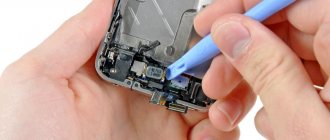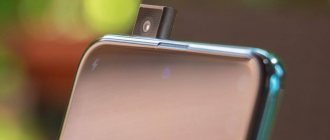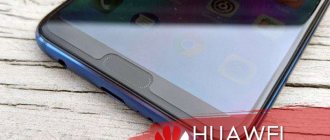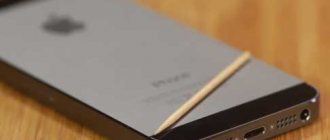Adding a fingerprint to a Xiaomi phone
First, let's learn how to add a fingerprint on Xiaomi and Redmi smartphones running MIUI 12. The procedure will only take a few minutes.
1.Open Settings and go to Passwords & Security.
2.Go to the “Fingerprint Unlock” tab, which looks like a large blue square.
3.Click on the “Add fingerprint” line.
4.Place your finger on the scanner from all sides. Hints will appear on the screen to help you position your finger correctly. Hold your finger in one position for several seconds, but do not press hard on the scanner.
5.When a notification appears that the fingerprint has been created successfully, click “Done” in the lower right corner.
This way you can add multiple fingerprints. They will be displayed in the settings under different numbers.
Note! Hands must be clean and dry. The print will not work if the skin has cracks or cuts. Also, you will not be able to unlock your mobile device using a scanner if you are wearing gloves.
Fingerprint sensor does not respond on Samsung
When we try to unlock a Samsung mobile using a reader on the screen or on the back and it does not work, we should not worry, this is something very repeated among users and in most cases the solution is simple. If you try it again, we won't find the key because it doesn't even vibrate or try to unlock the device.
Safe mode solves the problem
In one safe UI mode, many users have managed to fix the fingerprint reader errors . Some application can prevent its use and with this dome it will be disabled so that we can use it again. Once we check this, we just need to remove the recently installed applications and make sure that it does not reoccur in this way.
To access this mode on Samsung phones we must turn off the terminal or restart and hold down the power button until it appears until we see the Samsung logo. Then we will hold down the Volume Down button and when it ends we will see in the bottom corner Safe Mode.
Dry your mobile completely
Mobile phones are not good friends with water or humidity, and therefore if we have taken advantage of the water resistance of some Samsung Models we must remember to dry it completely. It is likely that additional drying time is required after immersion before the reader should return to normal operation.
How the fingerprint scanner works
The scanner can be located in three places: on the back of the case, on the side near the power button, or under the screen itself. The first two options are found in phones from the low and mid-price segment. Only flagship devices are equipped with under-screen scanners.
Now let's find out how the fingerprint sensor works. The lines on the fingers are called papillary patterns. Minutes (pattern sections) are interrupted, bifurcated and merged differently for everyone. It is because of this that the print is unique. The sensor remembers your papillary pattern, and the smartphone is unlocked only if a finger with the same lines touches the sensor.
Fingerprint sensors are divided into three types: optical, capacitive and ultrasonic.
1.Optical sensors are found in smartphones with AMOLED screens that implement under-screen technology. Essentially, it is a camera that takes a photograph of the fingerprint and stores it. Recognition occurs using light. The user needs to touch the display in a certain place, after which the lock will be removed. Of the minuses: the optical sensor begins to work incorrectly if dust or moisture gets on the display.
2. A capacitive scanner consists of conductive plates, the thickness of which is less than the papillary pattern. In such plates a capacitor with a current charge is formed. And the papillary pattern of each person is made up of unique protrusions and depressions. The sensor uses voltage to recognize them and determine who the fingerprint belongs to. Such scanners are placed on the case or near the power buttons.
3.Ultrasonic sensors were the last to be implemented in smartphones. This technology was introduced by Samsung. This is the best scanner option that can provide security by creating 3D images. Moisture and dust also do not affect fingerprint scanning.
How to solve a problem?
If you manage to find the source of the problem, you can begin repairing or adjusting the appropriate system parameters. If the problem cannot be identified, try the following steps before contacting a specialist.
- If there are no visible defects, clean the phone case from dirt.
- Then treat the sensor button with a cotton swab dipped in an alcohol solution.
- Wipe the device with a dry cloth, then try to activate it.
- Try updating the software version or, conversely, returning the previous settings.
- If there is no interaction with the system or if the pattern on your fingers changes, you can return the factory settings, and also change the finger used for activation in the settings.
IMPORTANT: To provide free diagnostics and repair of equipment, you must use the warranty.
To keep it valid, do not intervene on your own. Simply take the product to the store where you purchased it or to another service center.
Subscribe to our Social networks
Why does the fingerprint scanner not work?
Added a fingerprint, but it doesn't work? Let's look at three main reasons that can affect the performance of the technology.
Moisture ingress
Liquid has a detrimental effect on the fingerprint sensor. If water gets inside the case, the scanner will most likely stop responding to touch. To minimize the consequences, use the instructions below:
1.Wipe your phone thoroughly with a dry cloth. Liquid got inside the connectors or got stuck in the recess with the scanner - then use cotton swabs. Do not heat the device with a hairdryer, as this will only disperse moisture throughout all elements.
2.Place the smartphone in a plate with rice so that the grain removes moisture. Seal the bowl tightly and leave overnight.
3.In the morning, check the device again and turn it on. The scanner should work fine. If it still does not respond, contact the service center.
Mechanical damage
This is also a rather unpleasant situation, which is not always possible to cope with at home. Most often, the sensor is damaged due to improper disassembly of the phone when the scanner cable breaks. The problem can be solved in two ways: replace the tape yourself or contact a specialist.
A fall from a great height or other mechanical impact can also cause damage to the fingerprint sensor. This is especially true for optical sensors that are located under the screen and stop working if the display is damaged. Therefore, for practical purposes, it is better to purchase phones with a conventional capacitive scanner, which is more resistant to damage.
System error
Software glitches are rare on Xiaomi smartphones, but sometimes it happens. Some users note that after updating the firmware, the scanner stops working correctly. There are three ways to get rid of the problem:
1.Go to settings and create a new fingerprint and delete the old one. Life hack: for faster response, you can make several prints on one finger.
2. Discharge the phone to zero, and then fully charge it. Without unplugging the device from the outlet, test the operation of the scanner.
3.Reset Xiaomi to factory settings. Don't forget to save important information and make a backup before doing this.
Identifying the reasons why the fingerprint scanner does not work on Xiaomi and Redmi
Users often encounter a situation where the sensor does not recognize touches, but the reasons are unknown. System crash after the next update? Need a new fingerprint shot? Or maybe the cable was damaged altogether?
Before you begin repairs, you need to know exactly why the scanner is not functioning . There are two main options: either mechanical damage , which is quite difficult to fix at home, or a software error that disappears after a software rollback or update.
Mechanical failure
Let's start with the most banal and common one - when disassembling the device, you accidentally damaged the scanner cable . Physical damage may occur if the cover is pulled strongly without disconnecting the tape. Now, unfortunately, only a qualified master can help.
Don't know how to properly disassemble the back panel of your Xiaomi? We talk about this here.
Did your smartphone fall on a hard surface, or did you fill it with water? It is quite possible that after this the fingerprint sensor will refuse to work. Also pay attention to the condition of the back of the phone . Moisture, dirt, and grease will prevent normal contact. Wipe the case thoroughly and carefully use a cotton swab soaked in alcohol over the print button.
If there are cuts or even microcracks on the finger, the scanning will most likely not work . Hands should be dry and clean.
Consequences of the update
Xiaomi developers release improvements and innovations for their products with enviable regularity. But, in addition to innovative features, users are faced with slowdowns, glitches and various errors . This is an unchangeable component and a huge minus of the developer versions.
The global shell, of course, is less susceptible to such problems, but no one completely excludes them. So, if after the update you notice that the module has stopped working, your fingerprint scanner has disappeared, or there are interruptions in scanning, wait for the release of the next build , where all existing shortcomings will be optimized. As a last resort, roll back to the previous version.
Software glitch
Here, the first thing you need to do is delete the fingerprint and add a new one . It is also recommended to restart the device several times and completely discharge it, and then charge the battery to 100% .
If that doesn't help, try changing the default language to English in Settings and taking a few screenshots of the fingerprint. Then you can return to the Russian language. Such simple steps usually help restore the smooth functioning of the fingerprint sensor.
No actions can help restore the sensor’s functionality at home, but you don’t want to contact a specialist? Then simply disable the scanner lock and use standard security methods: an alphanumeric password, a pattern, or Face ID (the latter option does not have the best security parameters, so we cannot recommend face unlock).
Solving Common Problems
In addition to the complete inoperability of the sensor, users also encounter smaller problems. Let's discuss each case separately:
- The scanner does not always respond to touch; use a damp cloth to gently wipe the sensor. You can use an alcohol-based solution for cleaning, but only if the scanner is not located under the display.
- The “Fingerprint unlock” item is missing in the settings - restart your mobile device several times. If that doesn't help, do a hard reset.
- I can’t add a new fingerprint - again, resetting to factory settings will help.
Now you know what to do when the fingerprint scanner doesn't work. The above information applies to both budget devices (for example, RedmiNote 9) and flagship devices (Mi 8, Mi 9, etc.). If you have any questions, write in the comments, we will help.
How to solve various problems with a scanner on a smartphone
The fingerprint scanner has not stopped working, but are there interruptions and various kinds of problems? Below you will find the most common problems that users encounter and how to solve them.
The item is missing in Settings
Quite a strange but common situation. You go to “Settings” to add/remove a fingerprint, but this section simply does not exist , as if the smartphone does not have a scanner at all.
The only option that will help is a full reset to factory settings . You can learn how to return your smartphone to its original state in our special article. Just don’t forget to make a backup before doing this, otherwise you will lose important materials .
Another good option is updating via Three Points or installing full firmware . What is a complete ROM? We talked about this here in a separate paragraph.
The scanner does not recognize the fingerprint well
The above recommendations need to be repeated here. First, wipe the sensor area, then add a new fingerprint. As a last resort, reset the settings to factory defaults + completely clear the cache.
If the problem is a system glitch, it is best to update to a more recent version of MIUI.
New fingerprint is not added
Delete existing screenshots and try adding a new fingerprint through Settings. Again, a reset or update may help. In principle, the mechanism is the same everywhere : eliminating software and mechanical problems.
For more information, contact us in the comments, we will always help! Only in extreme cases will a service center be needed.
Solving the problem with the fingerprint scanner
Solving the problem with the fingerprint scanner
After we have understood the principle of operation of the fingerprint scanner, we can begin to solve the problem. As previously stated, the “fingerprint” function scans your finger, then uses an algorithm to search for matches based on existing images in the folder.
In order for the “fingerprint” to work in 99.99% of cases, you need to create as many folders as possible with images of your fingerprint. Typically, a standard smartphone supports up to 5 fingerprints simultaneously.
It is necessary to create the maximum number of fingerprints of the same finger. During this procedure, you will receive the message “such a fingerprint already exists” more than once - we ignore it and continue to place our finger at different angles until the smartphone accepts this image. After all these steps, you will have 5 folders and about 100 images from different angles of your fingerprint.
Now, when you put your finger to scan a fingerprint, the algorithm compares the fingerprint with 100 images, which minimizes the chance of error during recognition. During my personal testing, the scanner recognized the finger accurately in 99.99% of cases.
Setting up Touch ID correctly
Sometimes the iPhone 5s fingerprint scanner does not work well due to incorrect initial setup. Therefore, before you start using your new “smart” device, you should set up Touch ID, following Apple’s recommendations:
- Before setting up the sensor, enter the password for the device (4-6 digits, depending on the OS version). It is he who will help you unlock the device if the scanner suddenly malfunctions.
- Make sure the Home button and your hands are clean and dry.
- Go to settings under the “gear” icon, select “Touch ID and password”. Enter the code from step 1.
- Click on "Add fingerprint". After that, tap (don't press hard, just lightly) the Home button. At the same time, it is important to hold the device naturally and position your finger in the way that is most convenient for you.
- Once you touch the button, hold your finger until it vibrates slightly or until the text appears on the screen: “Lift your finger and place it on the Home key several times.”
- After this command appears, apply your finger, slightly changing its location.
- Next, the device will offer to enter a grip that is convenient for you into its memory. Here you should hold the phone in your hand in a way that will be convenient for you to position it in your hand when unlocking the device. At this point, you no longer apply the center of the fingertip to “Home”, but its edges.
- Once you have stored one fingerprint in memory, you can repeat the procedure for others. For greater reliability of the scanner, the iPhone’s memory should contain up to three of your fingerprints.
How to Fix “Touch ID Could Not Activate on This iPhone” Problem
To get rid of unsuccessful Touch ID activation, I recommend doing the following:
- Install update 10.3.3 for your iOS. For some users, the problem was solved in a similar way;
Install update 10.3.3 for your iOS
- Make sure you have the latest version of iOS installed;
- Also make sure your fingers, as well as the Home button, are dry and clean. If necessary, use a clean soft cloth to clean the surface of the Home button from dirt, moisture, etc.;
- Your finger should rest completely on the surface of the Home button, touching the metal ring surrounding the button. When scanning your finger with Touch ID, you should not press too quickly or move your finger around the button;
- If you use special tools to protect the screen, make sure that they do not cover the surface of the Home button or the ring surrounding the button;
- Go to “Settings”, select “Touch ID & Passcode” there, and make sure that the phone unlocker or “iTunes & App Store” is turned on (value “on”), and that the phone already has fingerprints of one or more of your fingers;
- Try adding another fingerprint to your phone;
- Use a forced restart of the phone. Press the “Home” and “Wake/Sleep” buttons for 15-20 seconds until the “Apple” logo appears;
- Try resetting your iPhone to factory settings. To do this, go to “Settings”, then to “General”, then to “Reset” - “Reset all settings”;
- If possible, roll back the system to the previous (before update 10) state (rolling back to update 9.3.5 helped some users);
- For some users, reconnecting the Touch ID cable helped solve this problem. To do this, you need to disassemble the iPhone, disconnect the Home button cable, and then connect it back. It is recommended to perform this operation if you have sufficient qualifications, otherwise you risk damaging the phone;
Reconnect the Touch ID cable
- If you are unable to add more than one of your fingerprints to the phone database, contact the Apple Retail Store or Apple Authorized Service Provider with this problem, and also try writing to Apple support;
- Visit your nearest service center, they may be able to help you fix the problem with Touch ID activation.
Recalibrating the Touch ID sensor
The easiest way to fix Touch ID errors is to recreate your fingerprint on your iPhone. iOS updates have done a lot of work over the past year, fixing most Touch ID errors including "Touch ID setup can't be completed," and there are general performance improvements on iOS 8 and above.
This may help if your fingerprints have changed slightly over the past few months due to wear, dry skin, etc. To do this you need to follow these simple steps:
Step 1: Launch the Settings app and open Touch ID & Passcode, enter your password when prompted.
Step 2: Select the fingerprint you are having trouble with, then click the Remove Fingerprint button.
Step 3. Click the “Add fingerprint...” button to begin rescanning the removed finger.
Step 4: Place your finger on the Touch ID sensor in different ways - from right to left, from top to bottom, and from side to side - until the fingerprint icon is completely colored.
Step 5: When asked to adjust your grip, scan the edges of that finger until the fingerprint icon is fully colored.
Note: Scan the front, back, and sides of this finger in the manner in which you think you will apply it to unlock if the grip is not the most comfortable.
Step 6: Click the Continue button when the process is complete to save your fingerprint.
Lock your device and make sure the fingerprint works; Congratulations if everything worked out! If not, reboot your device according to the instructions below and check if the problem is resolved.
How the algorithm works
How the algorithm works
When installing a fingerprint, you need to place your finger at different angles and repeat the procedure 10-15 times - at this moment the smartphone scans the “images” and saves them in a folder. This folder is then given a name, for example, “fingerprint 1”.
When you place your finger on the scanner to recognize your fingerprint, the smartphone algorithm begins to scan your finger and perform an analysis. The analysis is simple: the algorithm takes images from the folder and looks for 80-90% matches with the applied finger. If a match is found, the smartphone will be unlocked and made available to the owner; if no matches are found, the smartphone will also be blocked.
When users claim that the fingerprint scanner is bad because it does not recognize the finger, this is true, but only partially. Yes, indeed, in cheaper versions of the smartphone, scanners can save low-quality images, which makes fingerprint recognition difficult.
But what if the “fingerprint” does not recognize the finger in more expensive smartphones, even a cheap scanner? Possible, but unlikely. Each smartphone manufacturer has its own fingerprint recognition algorithm: some require a minimum of 70% matches, and some require 90%. Therefore, if the finger is not applied exactly to the scanner from the center, then algorithm errors may occur when scanning and analyzing the fingerprint. This has its pros and cons. Pros - enhanced protection, cons - does not always recognize a fingerprint.
Installation of a new mechanism
Engineers took care of such a replacement of the mechanism, so everything is not as simple as it might seem at first glance. When the home button does not work, in some situations it is easier to buy a new smartphone. An ordinary user will not be able to open a mobile phone without damaging some parts; even many specialists are not ready to take such a risk, which is why only highly qualified craftsmen with the necessary tools are required. Replacement is only needed if the button on the iPhone does not work after all operations. You should only contact an official service center, otherwise there is a high probability that the fingerprint on the Iphone 5s and other series will cause other problems.










